
Otherworldly Chess Problems and Solutions
Chess problems were a key component of Nabokov's multi-layered game of artistic deception. As the author declared in his 1962 interview for the BBC program Bookstand "deception in chess, as in art, is only part of the game...a good combination should always contain a certain element of deception". Likewise in the posthumously published chapter of his memoirs 'OnConclusive Evidence' Nabokov declared that riddling and mimicry could also involve a "camouflaged solution of a chess problem".
Hardly surprisingly, allusions to chess games abound throughout Nabokov's fiction and non-fiction. The main protagonist in his major chess novel The Defense (1964 [1930]), for example, is the insane chess player, Luzhin. Humbert plays three chess games in Lolita. Nabokov's 1947 novel Bend Sinister provides three descriptions of chess-like moves including "a lantern moved, knight-wise, to check him," "a cooked chess problem can be cured by the addition of a passive pawn" and "the only move I care to make is to rook my king the long side" (Bend Sinister, pp. 7, 84, 91).One chess problem in particular, which was devised by Nabokov in Paris in late 1939 or early 1940, was essential to his overall plan to ensure children were not seduced by predatory incestuous male relatives1. This strategy saw Nabokov engage in an intriguing duel against Lewis Carroll - played out in the symbolic language of chess. Nabokov's key chess problem and its accompanying commentary were originally published in the article 'Exile' in the Partisan Review in early 1951, following its earlier rejection by the New Yorker magazine. A letter sent in March 1950 by Nabokov to his New Yorker editor and friend Katharine White confirms that the author thought this chess problem was extremely important and was related, in some mysterious way, to the chess game plotted by Lewis Carroll in Through the Looking-glass. As Nabokov explained:
"When coming to the last pages of the piece 'Exile,' please remember that the frontispiece to the first edition of 'Alice in the Looking Glass' carries a very subtle and difficult chess problem, and I would not like to think that New Yorker readers could be more bewildered by my chess problem (which occupies only a few lines) than Dodgson's little readers" (Selected Letters, 99).Shortly after its publication in the Partisan Review, the chess problem in question was incorporated by Nabokov into Chapter Fourteen of his autobiography,Speak, Memory/Conclusive Evidence. It has since been reproduced in chess diagram format, in Poems and Problems (1972, p.182) where it is accompanied by Nabokov's succinct comment "composed in Paris, mid-May 1940…The irresistible try is for the bafflement of sophisticated solvers".
Within Chapter Fourteen of Speak, Memory Nabokov clearly indicated that his 1940 chess problem contained an encoded message. This can be inferred by how he ascribed specific qualities to his chess pieces. The Bishop, he explained, was a metaphor for a search light, whereas the Knight was "a lever adjusted and tried, and readjusted and tried again," (much like the nursery door-handle that must be tried and tried again to gain sexual access to a child) (Speak Memory, p.227). Chapter Fourteen ends with Nabokov's confessing that the controller who normally censored information had allowed some vital pieces of information to pass so that the concealed meaning of his chess symbols could finally be "divulged" (Speak Memory, p.230).
Lewis Carroll's Chess World
Along with Shakespeare's plays and the Bible, the two enchanted stories Dodgson/Carroll dedicated to Alice Liddell (i.e. Alice's Adventures in Wonderlandand Through the Looking-glass)are amongst the most widely read pieces of literature in the Western world. During her first Wonderland adventures Alice kept company with a weird assortment of characters, including a pack of animated cards. In Carroll's second Alice book, Through the Looking-glass, Alice is surrounded by animated chess pieces and is cast in the role of the White Pawn. Over the last half century, questions relating to the reasons for Dodgon's uneasy obsession with Alice have troubled the public's mind. One of the first writers to address this issue directly was the Scotsman Alexander Taylor, author of The White Knight (1952). In his book, Taylor surmised (correctly I believe) that Dodgson had masqueraded within the mirrored chess game as the lamenting, ageing White Knight. The quests of lonely knights featured reasonably regularly in Dodgson's writings. An earlier example is the 1862 poem Stolen Waters penned by Dodgson before he was rendered persona non grata in the Liddell household. Stolen Waters details how a knight was betrayed by a maiden who stole his heart and replaced it with a cold stone. He fears he is going mad, but then rejoices at the sound of "a rosy child" singing (Carroll 1989, 965). Ultimately the knight prefers the madness of her world, which contains death as well as eternity, to that of his own. (Stolen Waters is considered by some scholars to be Dodgson's most conscious confession to his pedophilia.)
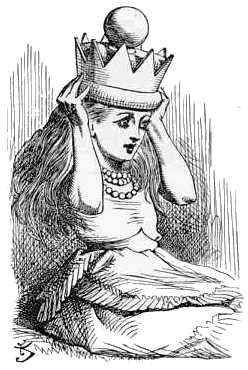
The central purpose of Carroll's chess game in Through the Looking-glass was to demonstrate the significance of a pawn's 'queening.' A pawn is 'queened' in chess when it reaches the opposite end of the board. Should it do so, it is typically exchanged for a queen, as this is the most powerful piece on the board. John Tenniel's still unsurpassed illustrations in Through the Looking-glass suitably depicted Queen Alice with a heavy golden crown on her head.
It is impossible to say categorically what this act of enthronement meant to Charles Dodgson. However, it is certainly possible that it may have reflected Dodgson's fervent wish that Alice could mature psychologically, and thus understand and respond to his sexual interest in her, while staying a child in every other way, especially physically.
The chess game in Through the Looking-glass was conveniently illustrated by Lewis Carroll with the following frontispiece:
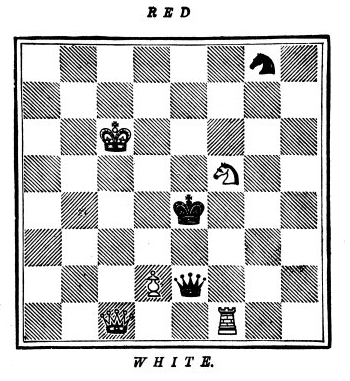
White pawn (Alice) to play, and win in eleven moves
[NOTE: actually white to play wins easily in three, but hey, who counts... -smr-]
Nabokov's Defense
When composing his chess problems Nabokov drew specific inspiration from the strategy Lewis Carroll's had adopted in Through the Looking-glass where the moves made by the various pieces on the chess board closely reflect the action unfolding within the narrative. Setting out on a mission to defeat Dodgson/Carroll Nabokov ensured that his 1940 chess problem similarly lurked as a ghostly presence behind the scenes of Bend Sinister (1947). Within Bend Sinister Vladimir Nabokov's quasi-autobiographical character, eight year old David, is admitted to an 'Institute for Abnormal Children' where he is sexually tortured by the other inmates. This 'Institute' is a variant on the 'police state of sexual myth' which Nabokov accused Sigmund Freud of creating and mythologizing.
Nabokov was especially suspicious of the phallic connotations attached to the opening move made by the Red Queen in Carroll's chess game, as illustrated in the chess diagram below:
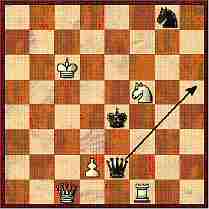
Figure 1
The Red Queen's move from square e2 to h5 could be regarded, à la Freud, as the symbolic equivalent of the phallus (or erect penis.). Nabokov was not alone in regarding the Red Queen's opening gambit with a jaundiced eye.
In The White Knight Alexander Taylor (1952, 101) similarly concluded that in devising his chess game Carroll "was not interested in the game as a game, but in the implications of the moves". Nabokov used the suggestive trajectory of the Red Queen as a foil for the elegant, solution he himself devised to the incestuous abuse of children by adult males. Nabokov's analysis of the malevolent undertow pervading Carroll's chess game where Alice is 'queened' motivated him to include a coronation scene as a crucial climax to the Lolita riddle. Acts of crowning (symbolizng learning the art of fellatio) and beheading (symbolizng castration) were destined to become key components of Nabokov's encoded language of incest.
In the stunning1940 chess problem Nabokov composed, White has been set the task of achieving check-mate in two moves. As the chess diagram at Figure 2 below illustrates, two pawns in this game face immanent danger of being 'queened.' The White Pawn on b7 is one square away from reaching the end of the board, whereas the Black Pawn on c3 is two squares away from his 'coronation.' If the Black Pawn advances from c2 to c1, we can expect it will be molested by the incestuously-minded Black Knight that stands, poised and at the ready, nearby.
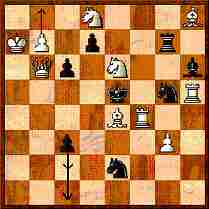
Figure 2
For White it is always tempting to advance the White Pawn to b8 where it would normally be exchanged for a queen. Within his memoirs, however, Nabokov idiosyncratically instructed that the pawn should be exchanged for a knight. (This may be Nabokov-speak for how a queened pawn, or sexually abused boy, is in danger of developing a pedophilic orientation as an adult.) In any case, whether it is exchanged for a knight or a queen, advancing the White Pawn to b8 (a ruse
that is the equivalent of the 'irresistible try') is the wrong move to make. White cannot ensure check-mate in the prescribed two moves if it 'queens' the pawn on b8. This is because Black can then move the Black Pawn on square d7 to d6, thus placing the White King under check from the Black Rook on g7. White must get out of check before it can proceed to check-mate Black and win the game.
Provided that we follow Nabokov's instructions and exchange the pawn for a knight, the author then insisted that the best move open to Black was to avoid placing the White King under check from the Black Rook. Instead he advised that the Black Pawn on c3 should be advanced to square c2. This move, I strongly suspect, is the equivalent of the "modest dilatory move" (Speak Memory, 230). Via this ingenious code Nabokov managed to divulge how Uncle Ruka escalated his abuse from fondling to anal digital penetration. (Ruka richly deserved his reputation as a 'bottom-feeler.') The Black Pawn is now only one move away from his fraught rendezvous with the Black Knight on square c1 and no chess piece can intercede to prevent its perilous advance.
Non-traumatic anal penetration can be very pleasurable for children (as well as adults). It is clear that this indelicate maneuver, performed by Ruka upon Vladimir, placed his nephew in grave and immediate danger. It set Vladimir off on a disastrous course whereby he agreed to meet his uncle in private. So began a long and painful period of sexual enslavement and tuition. Nabokov's acute sensitivity to how adults 'seduce' children in order to gain their co-operation and compliance (escalating from fondling, gift-giving, and lavishing the child with special attention to tickling games, and more sexual forms of stroking and genital contact) is well illustrated in Nabokov's novella The Enchanter where Arthur knows he must perform certain unspecified actions on Marie in order to awaken her sexual curiosity. This disastrous, seductive sequence of events, which invariably results in the 'queening' of a pawn, is precisely what the true solution to Nabokov's chess problem must prevent.
Rather than advance the White Pawn to b8, the best move open to White is actually to propel the protective White Bishop (i.e. the searchlight) into action. We must move the Bishop to occupy square c2 on the board, as illustrated in Figure 3 below:
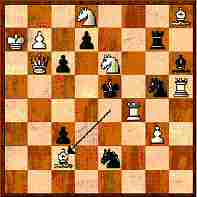
Figure 3
By occupying the square immediately in front of the Black Pawn the White Bishop stops the Black Pawn's advance. This effectively prevents the "modest dilatory move" from ever taking place. The White Queen is then free to check-mate the Black King by moving to c5 on the board, thus achieving 'end game' in the
prescribed two moves.
This, absolutely brilliant, two move solution accomplishes nothing less than a retrospective intervention which thwarts Vladimir's seduction at the hands of Uncle Ruka! What is additionally noteworthy about the White Bishop's protective move to c2 is that it literally deflates the phallic innuendos vested in the Red Queen's opening move in Through the Looking-glass.
Further complexity can be read into the Red Queen's opening move as it is the equivalent of a 'bend sinister' - a fact that goes a long way toward explaining the title of Nabokov's novel. Within heraldry, a bend sinister is a diagonal bar that, from the viewer's perspective, ascends from the bottom left to the top right. In the introduction to Bend Sinister Nabokov equated this trajectory with a mirror distortion, a mistaken choice and a sinister underworld. Heraldic bars commonly feature on coats of arms and flags of the European nobility. A bend sinister is considered by some heraldry experts to convey a sense of bastardry or illegitimacy.
On a purely symbolic level, Nabokov's stunning two-step solution achieves much more than Vladimir's retrospect rescue. Theoretically speaking, it organises the rescue of every child who is suffering (or who has suffered) sexual abuse at the hands of a male perpetrator. It does so by, quite literally, deflating the erect penis! Nabokov was perfectly well aware of the importance vested by Freud (and patriarchy in general) in the phallus. Freud ably communicated a sense of the phallus' significance in the oedipal myth, where the fear of castration compels a young boy to relinquish his first 'erotic object'- his mother. It is now possible to see that the defensive trajectory of the White Bishop was meant to tackle and defeat Freud on an entirely different level. This second, perhaps even more astonishing coup de grâce, explains why within Speak, Memory, Nabokov discussed inventing a chess strategy "with an unusual line of defense; it might be a glimpse of the actual configuration of men" (i.e. it might imitate a part of the male anatomy.) The author went on to explain that this line of defense was intended to encapsulate, "with humor and grace," a difficult theme he had long otherwise despaired of expressing (Speak, Memory, 226).
The protective move made by the searchlight White Bishop discloses yet another fervent wish on Nabokov's part. The solution requires a vigilant adult or parent (the White Bishop) to watch over the child (the Black Pawn) to prevent the dangerous 'modest, dilatory' move that rendered Vladimir vulnerable to accepting Ruka's (the Black Knight's) invitation to meet with him in secret and be 'queened.' The solution vividly communicates Nabokov's profound desire that his mother Elena had intervened in Ruka's activities, just as Lorina Liddell had once done with Charles Dodgson. On a macro-conceptual level, Nabokov's chess problem solution provides astonishing proof of the author's immodest claim to "think like a genius" (SO, xi). I can only say that I applaud his intentions, understand his wishes and in terms of its sheer technical brilliance, I take my hat off to him.
1. Nabokov did not address the issue of the sexual abuse of children by female adults. Research in the human sciences indicates that women constitute a minority of child sex offenders at between 5% - 20%. Female child sex offenders are rarely motivated by pedophilia (i.e. an erotic attraction to the biological child.) My decision to focus in on Nabokov's concern with pedophilia and incestuous male relatives should in no way be interpreted as underestimating the trauma and confusion experienced by children who are sexually abused by female adults.